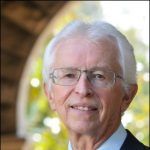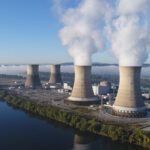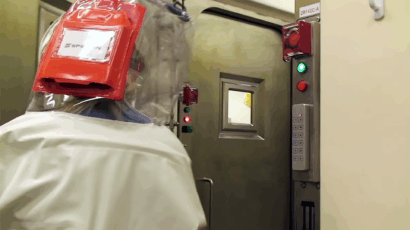South Korea’s model nuclear energy program
By Peter E. Davis, Siegfried S. Hecker | February 19, 2014
“That one is going to Georgia,” our guide said through her megaphone. We were standing in the cavernous Doosan Heavy Industries factory in Changwon, South Korea, looking at a number of pressure vessels bound for nuclear power plants around the world. “Georgia, United States?” one person in our group asked. “Yes,” our guide replied, “we are manufacturing the pressure vessel for the Vogtle Nuclear Power Plant being built in Georgia, USA.”
South Korea has become a global leader in nuclear energy. Our tour of the Doosan Heavy Industries plant—and our realization that South Korea is providing some of the principal components for the four American nuclear reactors under construction—epitomize how far Seoul has come since it signed its first nuclear cooperation agreement with the United States 40 years ago.
The story of South Korea’s nuclear development offers a model that countries aspiring to obtain nuclear energy should emulate. It is a story that demonstrates the promise of nuclear integration, the advantages of forgoing front-end and back-end nuclear fuel cycle technologies to focus on the middle of the fuel cycle, and the spillover benefits of a strong domestic nuclear industry.
The South Korean story also holds a lesson for Iran, which pursued a different path, making domestic enrichment the centerpiece of its nuclear quest. The proliferation danger of enrichment coupled with the clandestine nature of much of Iran’s nuclear program has justifiably raised nuclear weapon suspicions. Tehran’s refusal to cooperate fully with international inspectors has resulted in crippling sanctions and global isolation. Today, Tehran has little to show for its nuclear investment, in stark contrast to South Korea’s success.
To be sure, the meteoric rise of South Korea’s nuclear power industry has not come without challenges. Its accomplishments were recently overshadowed by widespread concerns over counterfeit parts and corruption. In 2012 and 2013, evidence surfaced indicating that numerous components in Korean nuclear reactors were counterfeit and had forged safety certificates. The revelations resulted in the shutdown of multiple nuclear reactors and the indictments of more than 100 people, including top officials in the Korean nuclear industry, on corruption charges. More importantly, the scandals have contributed to a loss of public trust in South Korea’s capacity to run nuclear reactors safely.
Nevertheless, if the government succeeds in reassuring the public that its reactors are safe through greater transparency and openness, South Korea can ensure that its nuclear industry remains among the most competitive in the world, and a model for nuclear aspirants to follow.
The path to success. When it set out to pursue nuclear power, South Korea struck close business alliances with established reactor and equipment vendors from the United States, Canada, France, and Japan. After construction of three turnkey units by Westinghouse and Atomic Energy of Canada Limited in 1978 and 1983, South Korea transitioned to using domestic firms to construct subsequent plants, though components were still principally supplied by foreign subcontractors.
Between 1986 and 1988, South Korea negotiated contracts with US-based Combustion Engineering and a number of other reactor component makers that required technology transfer in order to supply parts and licenses for reactors at Yonggwang 3 and 4. Korean companies again led the construction efforts, and robust technology transfer on nuclear supply steam systems, fuel fabrication, and core design from Combustion Engineering made the project a model for future Korean plants.
South Korea’s approach allowed it to launch the essential elements of a nuclear industry by bringing the country’s industrial corporations up to speed in reactor component manufacturing, reactor construction, and balance-of-plant equipment manufacture—the middle of the nuclear fuel cycle—while simultaneously putting nuclear electricity on the grid quickly. The technology-transfer requirement for Yonggwang 3 and 4 assured that by 1989, future reactors could be developed and built primarily at home, an ingenious strategy that signaled Korea’s quick rise.
In 1974, the United States and South Korea signed their first Civil Nuclear Cooperation Agreement (called a 123 Agreement for Section 123 in the 1954 US Atomic Energy Act). This agreement steered South Korea to focus on developing the middle of the nuclear fuel cycle. It strongly discouraged enrichment on the front end and reprocessing spent fuel on the back end of the fuel cycle by not giving advance consent for South Korea to employ these technologies on US-supplied uranium.
Washington put these restrictions in place for many of its international 123 agreements due to the proliferation potential of enrichment and reprocessing technologies. These restrictions proved important: South Korea explored a nuclear weapon option in the 1970s because it was concerned about the Nixon and Carter administrations’ commitment to guaranteeing South Korea’s security in light of increasing threats from North Korea. However, heavy pressure from Washington convinced Seoul to sign the Nuclear Nonproliferation Treaty in 1975 and give up its weapons ambitions by the early 1980s.
Seoul’s decision to abandon a nuclear weapon option and forego development of proliferation-sensitive enrichment and reprocessing capabilities allowed it to integrate its fledgling domestic reactor industry with established nuclear vendors. South Korea proceeded to establish itself as one of the most advanced nuclear power countries in the world.
Korea’s nuclear development also had a positive impact outside the industry. Its focus on manufacturing reactor components and balance-of-plant equipment led to major improvement and expansion in the country’s steel, machinery, and electrical equipment sectors—culminating in the success of multinational companies like Doosan Heavy Industries, which build not just nuclear power plants but also marine vessel components, desalinization plants, and much more. South Korea’s growing expertise in nuclear fuel fabrication has also benefitted other areas of high-tech manufacturing and advanced scientific research. These spin-offs from its nuclear industry have supported South Korea’s remarkable economic rise.
South Korea is now poised to become one of the world’s major reactor exporters. It currently operates 23 nuclear reactors domestically that generate 26 percent of its electricity and plans to build 11 more by 2024. (Five are currently under construction and nearing completion.) Korean companies, led by Korea Electric Power Corporation (KEPCO), are currently building four nuclear reactors in the United Arab Emirates, and have ambitions to export indigenous reactors and components to other aspiring nuclear states.
Based on this success, South Korea asked the United States to grant advance consent rights for enrichment and reprocessing in the 2014 renewal of the 123 agreement. Seoul, with some justification, claims that the success of its nuclear program and its stellar nonproliferation record over the past 30 years warrant a more liberal deal from Washington. However, Washington’s global proliferation concerns led to a two-year extension of the original agreement to allow additional time for the sides to work out their differences. South Korea’s nuclear industry still requires US consent because American companies maintain licenses on crucial aspects of Korean reactor components and ancillary equipment.
Lessons from Seoul. Together with South Korean and Stanford University colleagues, we examined the technical, economic, and political aspects of Korea’s nuclear fuel cycle to provide an independent assessment. We concluded that in the short term, South Korea should continue to build on its middle-fuel-cycle efforts and develop interim dry-cask storage for its spent nuclear fuel. Enrichment is economically and technically unattractive, and it is politically divisive. South Korea should also continue its innovative pyroprocessing research for potential future application.
In the long term, if South Korea believes it must have domestic enrichment capabilities, it should pursue these multilaterally with established vendors. Reprocessing may be necessary if South Korea decides to pursue fast reactors and close the nuclear fuel cycle. At this point, however, South Korea should continue to emphasize the parts of the fuel cycle that have made it a leader in nuclear energy, while continuing to purchase inexpensive enrichment services on the global market and store its spent nuclear fuel.
What lessons should aspiring nuclear-energy states take from South Korea’s success? Clearly, they must abandon the pursuit of nuclear weapons and provide the necessary transparency to convince others of the peaceful nature of their nuclear programs. They should, at least initially, forego enrichment and reprocessing and instead develop the more economically profitable and less proliferation-sensitive middle of the fuel cycle.
South Korea’s experience also shows that it is critical to partner with countries that have successful nuclear industries and regulatory systems. Such partnerships should be structured to provide experiential learning and technology transfer to speed up domestic development. Even then, it will take several decades of dedication to build significant industrial capacity.
For Iran, the lesson is clear: Tehran should abandon its enrichment efforts because the costs—technological, economic, and political—are not worth the price of keeping the weapon option open. Iran should pursue the more profitable middle of the fuel cycle, just as South Korea has done for decades. However, for Iran to succeed along this path, Washington must support Iran’s integration into the international nuclear energy community, rather than isolate it.
South Korea is a model for the national benefits of this type of nuclear integration. If it moves decisively to resolve concerns related to counterfeit parts, and is able to negotiate a fair and beneficial new 123 agreement with Washington, it can ensure its status as a global leader in nuclear power.
Together, we make the world safer.
The Bulletin elevates expert voices above the noise. But as an independent nonprofit organization, our operations depend on the support of readers like you. Help us continue to deliver quality journalism that holds leaders accountable. Your support of our work at any level is important. In return, we promise our coverage will be understandable, influential, vigilant, solution-oriented, and fair-minded. Together we can make a difference.
Topics: Analysis, Nuclear Energy
















